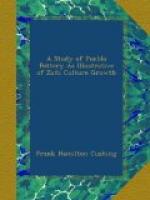[Illustration: FIG. 548. FIG. 549.
Conical
canteen compared with human mammary gland.]
By that tenacity of conservative reasoning which is a marked mental characteristic of the sedentary Pueblo, other types of the canteen, of later origin, not only retained the name-root of this primeval form, but also its attributed functions. For example, the me’ wi k’i lik ton ne (See Fig. 550) is named thus from me we, mammaries, i ki lik toi e’, joined together by a neck, and to’m me.
Now, when closing the ends (Fig. 550, c, c) of this curious vessel in molding it, the women are as careful to turn the eyes away as in closing the apex of the older form. As the resemblance of either of the ends of this vessel to the mamma is not striking, they place on either side of the nozzle a pair of little conical projections, resembling the teats, and so called. (Fig. 550, b.) There are four of these, instead of, as we might reasonably expect, two. The reason for this seems to be that the me’ wi k’i lik ton ne is the canteen designed for use by the hunter in preference to all other vessels, because it may be easily wrapped in a blanket and tied to the back. Other forms would not do, as the hunter must have the free use not only of his hands but also of his head, that he may turn quickly this way or that in looking for or watching game. The proper nourishment of the hunter is the game he kills; hence, the source of his life, like that of the young of this game, is symbolized in the canteen by the mammaries, not of human beings, but of game-animals. A feature in these canteens dependent upon all this brings us nearer to an understanding of the question under discussion. When ornamental bands are painted around either end of the neck of one of them (Fig. 550, b), they are interrupted at the little projections (Fig. 550, b,). Indeed, I have observed specimens on which these lines, if placed farther out, were interrupted at the top (Fig. 550, a a) opposite the little projections. So, by analogy, it would seem the Pueblos came to




